A school of electric fish. 20 new wave power ideas.
by Unenergy
Fri Dec 05, 2008 at 03:05:36 PM PDT
From 1-12 December, for 12 days Poland hosts the 4th meeting
of parties to the Kyoto Protocol. According to the UNFCCC website 185 parties comprising over 9000 participants will meet to map out the negotiation plan of action for the replacement to the Kyoto Protocol. As this is an important meeting to discuss what is in effect the future policy decisions many world governments will need to take to combat climate change, it may be of some interest to discuss exactly what advances in wave energy technologies are being developed which minimize carbon emissions.
http://unfccc.int/...
- Unenergy's diary :: ::
-
A few days ago, a gnostic posted a diary about a new underwater device developed by the University of Michigan called VIVACE, which could be one of the possible low emission electricity devices commercialized and deployed in low flow river systems. In this diary I intend to point out 20 more similar water based electric generation devices. These are the sort of devices which should be installed in places where they would sustainably generate renewable electricity with a lesser impact than that of fossil fuels.
Pelamis Wave power
According to this presentationby Pelamis, each of their installations is designed to generate 750kW with up to 40% availability. The Pelamis design is a 140 meter long 3.5M diameter, 4 main segment with 3 joint, which sits semi-submerged facing into the oncoming ocean waves. Pelamis first commercial installation 3 miles off the coast of Acuador, Portugal, consists of 3 units, capable of producing 2.25MW of power at peak output (enough to power 1,500 homes), and of which further plans are underway to install 25 further units with a net peak output of 21MW. The units rely on the motion of the waves to internally pressurize a hydraulic system to drive an electrical generator. Pelamis have indicated over a 1km2 area 40 Pelamis units would have the capacity to generate 30MW of power (peak), or enough to supply 20,000 households with electricity.
As well as Pelamis being involved in the UK’s plans to build a WaveHub, it also appears Google may be paying attention having lodged what appears to be a patent incorporatingthis 10 year old companies design.
WaveStar Energy
This technology relies on what has been termed multi-point absorbtion. According to the write up on their prototype which has been installed since 2006 at Nissum Bredningin Denmark, the design was conjured up by a couple of sailing professionals, Niels and Keld Hansenand later sold to Pers Resen Steenstrup for commercial development.
The installation at Nissum Bredning is a 1:10 scale model capable of producing 5.5kW of electricity, again via a pressurized hydraulic system using accumulators which pressurize the system to 200 bar and in turn a hydraulic turbine. The system is capable of producing power 90% of the time with 30% being at maximum rated output. The next scale unit is being built at 3MW with the final unit designed to output 6MW of power at peak. The developers have indicated in their presentations that because very few components of the design are actually in contact with sea water they expect the system to operate for 50 years with a major maintenance overhaul every 10 years. One of the investors in this technology, Jorgen Mads Clausen is managing director of one of Denmarks largest industrial automation companies, Danfoss, so the capacity in terms of engineering support does appear available to fully commercialize this product.
AWS Ocean Energy
AWS Archimedes waveswingis the first product this company intend to deploy in 2010 with a roll out of a 250kW model. Backed by Shell Technology Ventures (yes the investment arm of the oil company) and others, the company site states that from an area 3 nautical miles long (5.5km) and 2 wide (3.7km) it can produce 50MW of electricity.
An article on the technology can be found here. AWS have a substantial list of Directors and Management teamto guide this technology through to commercialization.
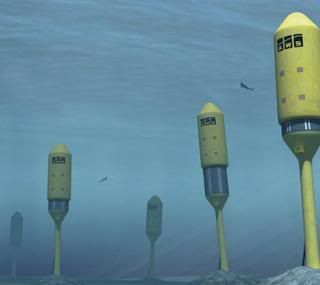
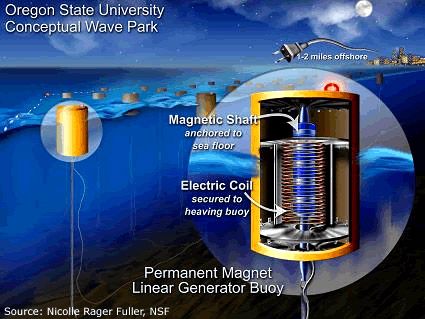
Wave Dragon
Based on an overtopping principle where waves are able enter a floating, slack moored artificial dam, the first deployment of this design is already in place in Nissum Bredning, Denmark. The idea is for waves to enter an elevated area above normal ocean level, using this elevation to harness the power of exiting water via a turbine outlet. By creating a differential in pressure, known as a head, the first deployment is able to generate 20kW, however the plans are in place to deploy a standard 7MW unit sometime in 2009 after prototype testing is complete.
Wavegen
According to their website, WaveGen is a Voith and Siemens company, which claim that 30% of all of the electric-hydro power generated in the world today is produced by their turbines. WaveGen have had plans using their technology submitted for a 4MW power plant on the Isle of Lewis, Scotland and have recently commissioned a 100kW unit. The technology of WaveGen is called oscillating water column where the movement of the waves is used to move air in and out of a chamber. This air is passed through a turbine to generate electricity. Source
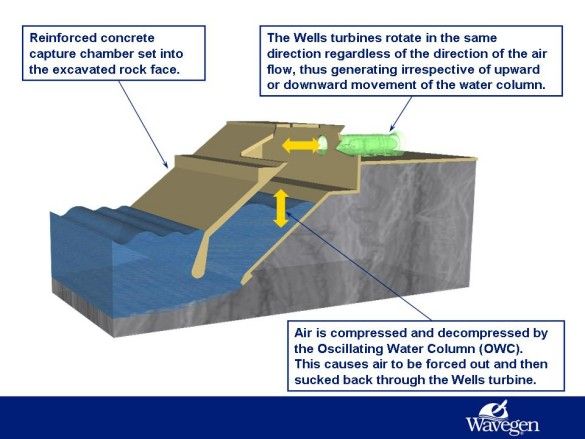
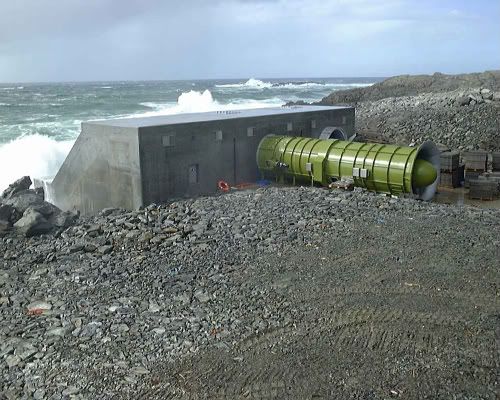
Oceanlinx
Established in Australia in 1997, Oceanlinx claim their oscillating water column design is significantly more efficient than the WaveGen design.
Oceanlinx have been successful raising Australian government financial support on a number of occasions and have to date had at least 3 successful Venture capital raisings for £6M, £5.9M and $AUD16M from February 2007 to September 2008.
There are at least two operational Deniss-Auld turbines one here, another here, both located in Port Kembla Australia. Projects Oceanlinx have publicized Memorandums of Understanding for include a 450kW Port Kembla project, 5MW in Cornwalls Wave Hub, 1.5MW followed by 20MW in Rhode Island, 1.5MW followed by 15MW in Namibia and up to 2.7MW in Hawaii.
Each unit is up to 1.5MW at peak output.
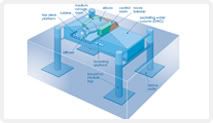
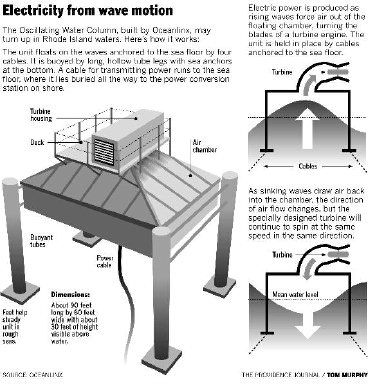
Syncwave Systems Inc
This technology is based on capturing the motion differential between two dissimilar float structures. Power is captured by a hydraulic power take off. Units are 100kw and looking at the specifications, these floats are 30M in length. The video on Syncwave’s site did not work on my PC so be a little careful when viewing it, and the only other detail I can provide is Syncwave are working with University of Victoria and Marinus Powerof Houston to commercialize this idea.
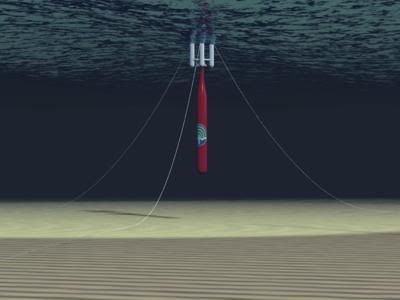
Waveroller
Waveroller relies on ocean surge to drive a plate backwards and forwards, pressurizing a hydraulic system coupled to an electrical generator.
Commercial development of this device is ongoing with a second wave roller unit recently deployed.
Wave energy
Based in Norway, this company has designed an overtopping design which instead of floating will have a multistage turbine and 3 levels of water reservoirs. There are a number of places this can be installed including Onshore,as a breakwater or as an offshore installation (possibly on retiring oil rigs).
WaveEnergy have received a couple of rounds of funding from Enova, institutional investors and Norways government. As ofJanuary 2006, this was supposedly enough to build the first operational plant at Kvitsoy, however no further detail can be found to confirm this.
Seabased
There is very little I could find out about this company apart from a single page cached website (link above). The design is based on a floating buoy connected to a 3 phase linear alternator and spring. This company has been developing their technology with Swedens Uppsala University and have had environmental assessments ongoing since 2004.
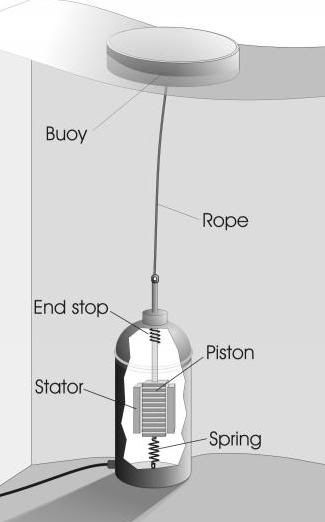
Offshore Wave Energy Limited (OWEL)
This technology again uses air in an oscillating water column arrangement. According to their site, the technology is being developed with funding from a 2 year Development program sponsored by a Carbon Trust Grant. The company have completed tank testing and are planning a final development phase to Design and construct a full scale model most likely at EMEC off Orkney. No details on generation capacity could be found on their site.

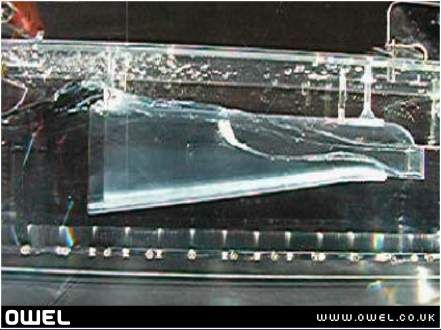
Orecon
Orecon have taken the idea of Oscillating Water columns one step further than Wavegen, Oceanlinx or OWEL, by combining more than one and in effect achieving economies of scale. Their design is for a ocean based floating unit with multiple resonant chambers capable of generating 1.5MW. Orecon have secured backing by a number of significant Venture firms with $24M raised in March 2008. According to arecent article, Orecon have also been contracted to contribute to the UK’s $43M USD Wave Hub.
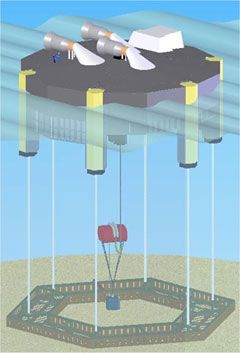
Ceto
One of the first technologies I knew about, Ceto have been working towards commercialization of an underwater buoy for a number of years. With Carnegie Corp owning the rights to develop the technology in the Southern Hemisphere and Renewable Energy Holdings in the Northern, this technology is well on the way to commercial realization. According to Carnegies latest report these buoys are capable of pressurizing water to 64 bar which is enough to both turn a turbine or alternatively desalinate water. They have also commissioned a study which indicated that within 25 Metres of Australias coastline, the total wave based resource for base load power generation was 170,000MW. This is significant as Australias total generation capacity is only around 40,000MW. So this one technology alone, could service 4 and a half times their total electricity requirements. In the Northern Hemisphere Ceto will be developed with EDF and already a 2MW MOU has been signed for Bermuda with a subsequent 20MW planned.
I have another page up here for more information on this technology.
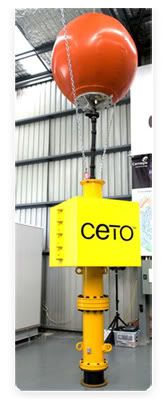
Ocean Power Technologies
Started in 1994 with sea trials commencing in 1997, Ocean Power Technologies PowerBuoy operates by harnessing the up and down movement of waves via a power take off drive. Over an ocean area of only 30 acres (0.125sqkm), OPT claim their buoys are capable of generating 10MW. Projected costs for this technology at mass production are 5c/kwh. Alongside deployments at Oahu, Atlantic City, Santona Spain, OPT have received funding from the DOE, reserved a berth for 2MW of plant in EMEC, and signed a $3M with the US Navy. The buoys are 9m (29.5 feet) deployed and capable of generating up to 40kW.
Finavera Renewables
Utilising theAquaBuOY platform, Finavera are intending on building projects in British Colombia, Humboldt County, South Africa, and Makah Bay.The AquaBuOY consists of four elements – Buoy, Acceleration Tube, Piston and Hose Pump with constructionwell underway.
They have posted a video explaining the principal behind wave energy and have deployed the first unit off the coast of Oregon with the next modelcapable of producing 250kW of power.
Ocean WaveMaster
Formed in 2002 to develop a technology which utilizesthe differential pressures under wave peaks and troughs to drive submerged turbines. The wavemaster concept is here with theproof of concept and tests conducted a possible scalable version of this technology would be capable of producing50kW with a 1 Metre wave swell.
In 2003, Wavemaster received funding from the Carbon Trust to work with NaREC to build and install a 20mproof of concept model. Testing appears to be ongoing as this is the last update on their site.
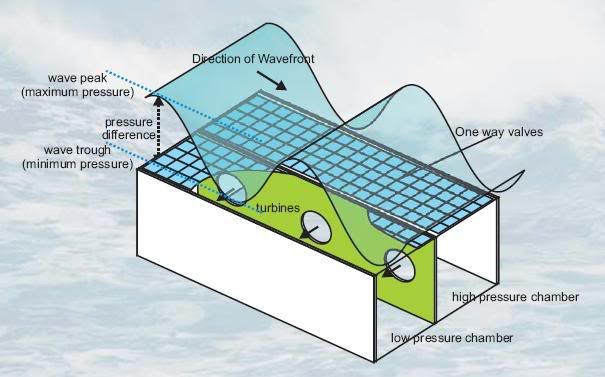
Wave Energy Technologies
Based in Canada, this technology named theWET EnGen is capable of converting ocean energy into mechanical energy to either generate electricity or produce desalinated water.
The system works by having a secured mooring with a protruding spar attached and a mounted power conversion mechanism attached to a float, moving up and down with the waves.
The company is currently commercializing the technology and are looking for investment partners for its 200kW design which they claim will be able to produce power from 8ckWh to 15ckWh short term with long term target of 5ckWh.

WaveBob
Originally founded in Ireland in 1999, WaveBob is now working with Chevron, Vattenfall and Georgia Tech Research Institute and targeting a market of offshore oil and gas, utility companies and Renewable energy developers for their product. The buoy itself is quite large with a 20m diameter and 8m height, and according to WaveBobs website is capable of producing 500kW of power. WaveBob have plans for a wave farm off the West Coast of Ireland and have opened a US branch in Annapolis.
SeeWec
Seewec is a consortium of partners including ABB, Ghet University, Spiromatic, Standfast Yachts, Brevik Engineering, Marintek, Norwegian University of Science and Tech, Institute of Superior Tech (Portugal), Chalmers University of Technology (Sweden), Fred Olsen Ltd, Natural Power Consultants, who are developing a Multi-Point absorber Technology in floating platform.
The development of this technology started in 2001 and this technology has completed testing in a wave tank in 2004 (1:20 model)with a launch of their sea based unit in 2005 (1:3 model). Current progress is unknown, although they have presented their findings at a number of trade shows.
CWave
Working with Wolfson Unit, CWave have produced a working concept device. Capable of harnessing the continual gap between waves, further development of this concept unit is a little hard to tell as last news item was 2006 and no recent information appears on their site.
So that is the first 20, with 21 more to go. I will come back to this technology and complete the remainder on this page in the coming week. But for the moment I am moving on to something different. For the full list of technologies I have put together you can go to this site.
Hopefully the UNFCCC is discussing similar solutions to the challenges of climate change.
And maybe these are the type of technologies which could help kick start the US Economy by providing new industry for America in the Green tech field.
































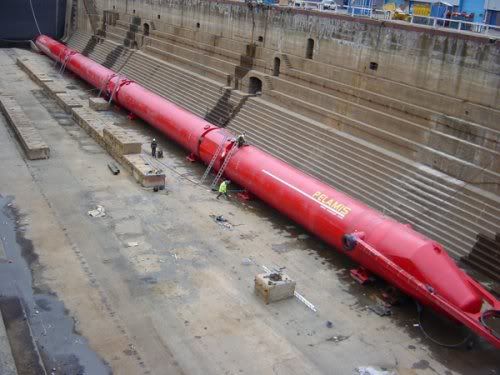
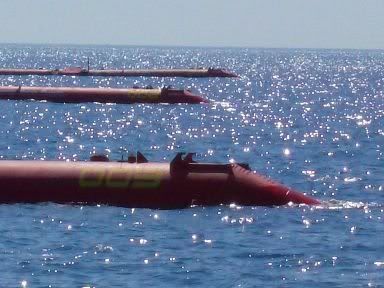
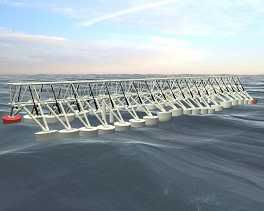
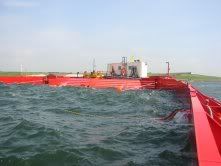

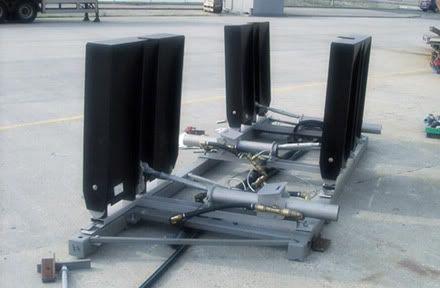
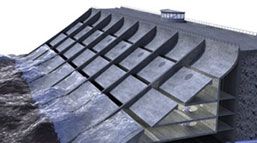

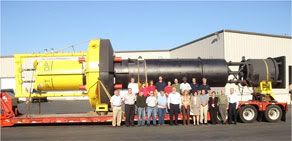
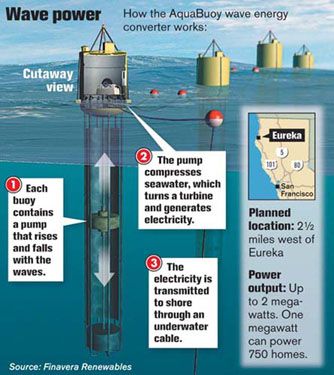

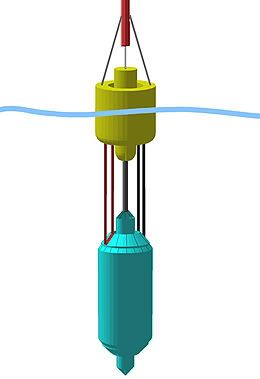
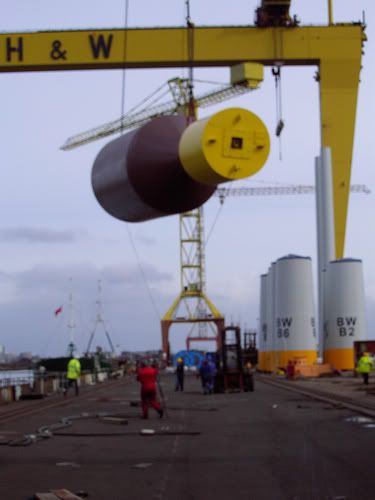
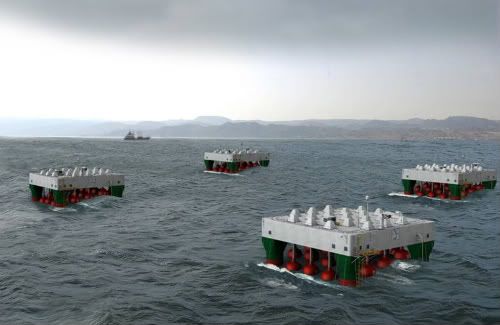
























































Keine Kommentare:
Kommentar veröffentlichen